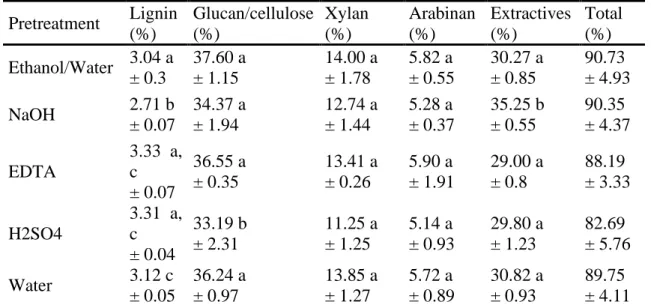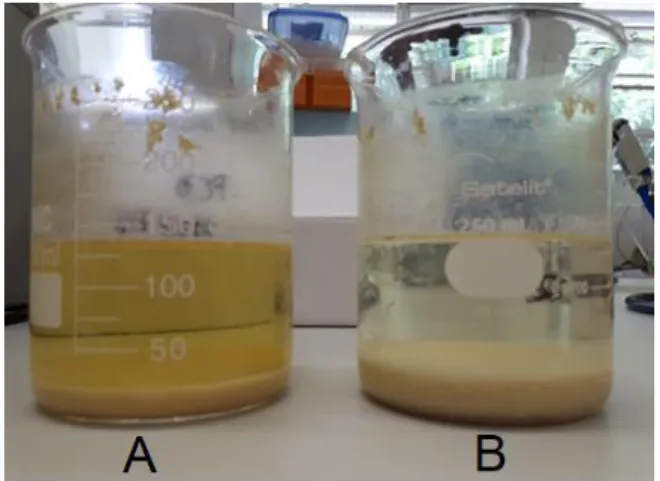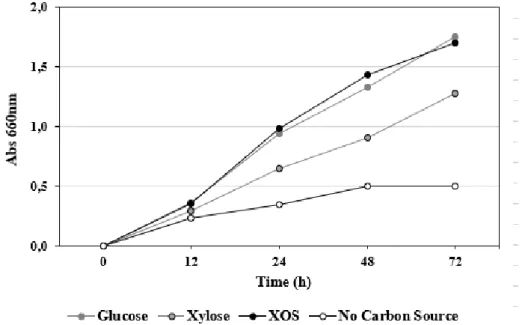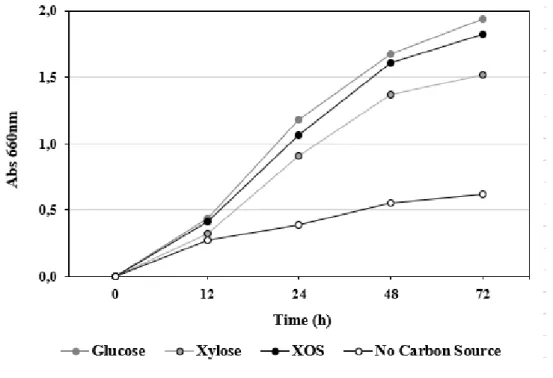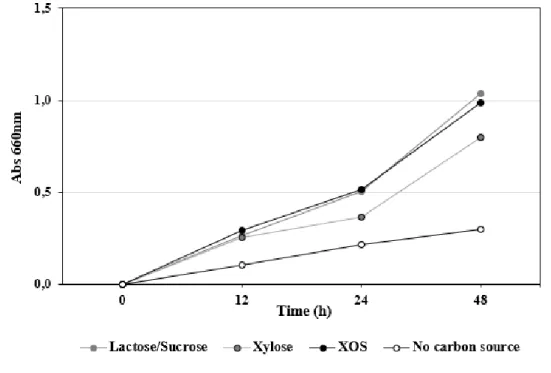Braz. J. of Develop.,Curitiba, v. 6, n. 9, p. 73400-73411, sep. 2020. ISSN 2525-8761
Evaluation of xylooligosaccharides effect on the growth of probiotic
microorganisms
Avaliação do efeito de xilooligossacarídeos no crescimento de
micro-organismos probióticos
DOI:10.34117/bjdv6n9-701
Recebimento dos originais: 26/08/2020 Aceitação para publicação: 30/09/2020
Caroline de Freitas
Master in Applied Microbiology
São Paulo State University (UNESP), Biosciences Institute, Biochemistry and Microbiology Department
Endereço: Avenida 24 A, 1515 – Bela Vista - Rio Claro / SP, 13506-900 e-mail: caroline.freitas@unesp.br
Cárol Cabral Terrone
PhD in Applied Microbiology
São Paulo State University (UNESP), Biosciences Institute, Biochemistry and Microbiology Department
Endereço Avenida 24 A, 1515 – Bela Vista - Rio Claro / SP, 13506-900 e-mail: carolterrone@hotmail.com
Eleonora Cano Carmona
PhD in Applied Microbiology
São Paulo State University (UNESP), Biosciences Institute, Biochemistry and Microbiology Department
Endereço Avenida 24 A, 1515 – Bela Vista - Rio Claro / SP, 13506-900 e-mail: ecarmona@rc.unesp.br
Michel Brienzo*
PhD in Biotechnology
São Paulo State University (UNESP), Bioenergy Research Institute (IPBEN) Endereço Rua 10, 2527 – Santana – Rio Claro / SP, 13500-230
e-mail: michel.brienzo@unesp.br
ABSTRACT
Xylan is the hemicellulose with the highest incidence in agricultural and agroindustrial residues. Xylooligosaccharides (XOS) are xylose oligomers recognized for their prebiotic potential, in addition to other biological properties that promote health. XOS were produced through enzymatic hydrolysis and their prebiotic effect was evaluated. Mostly, XOS with a high degree of polymerization were produced. The microorganisms used were able to grow in the medium containing the XOS produced.
Braz. J. of Develop.,Curitiba, v. 6, n. 9, p. 73400-73411, sep. 2020. ISSN 2525-8761
RESUMO
A xilana é a hemicelulose com maior incidência em resíduos agrícolas e agroindustriais. Os xilooligossacarídeos (XOS) são oligômeros de xilose reconhecidos por seu potencial prebiótico, além de outras propriedades biológicas que promovem a saúde. XOS foram produzidos através de hidrólise enzimática e o seu efeito prebiótico foi avaliado. Majoritariamente, foram produzidos XOS com alto grau de polimerização. Os micro-organismos utilizados foram capazes de crescer no meio contendo os XOS produzidos.
Palavras-chave: Xilooligossacarídeos; xilana; xilanase; prebióticos; probióticos.
1 INTRODUCTION
Due to the growth of agricultural and agro-industrial activities, millions of tons of lignocellulosic residues, the largest source of biomass in the world, widely available and renewable, are generated worldwide per year (Barreto et al., 2015).
Among the agro-industrial residues, banana pseudostem is produced in large quantities through banana cultivation in Brazil, which is the third largest producer of this fruit in the world. For each ton of banana produced in the country, approximately 3 tons of pseudostem are generated, which are usually abandoned in the soil. Therefore, the exploitation of this residue to produce compounds with higher added value is beneficial to the environment, besides generating products of interest for human and animal consumption (Li et al, 2010).
Hemicelluloses present in agricultural residue, especially xylan, have great economic potential and have found increasing applications. Xylan is a polysaccharide whose structure is comprised by a chain of D-xylose residues linked through β-1,4 bonds (Zhang et al, 2016; Álvarez et al, 2017). The main enzymes responsible for hydrolysis of xylan chain are endo-1,4-ß-xylanases and ß-xylosidase. The endo-β-1,4-D-xylanases (EC 3.2.1.8) act on the main xylan chain and the products formed by their action are xylooligosaccharides (XOS) (Goswami; Rawat, 2015; Freitas et al., 2019).
XOS are oligomers consisting of xylose units linked through glycosidic β-1,4 bonds. Considered prebiotics, XOS are not degraded in the stomach, arriving intact in the intestine thanks to the absence of enzymes capable of performing the hydrolysis of β type bonds in the human body and promoting the proliferation of beneficial microorganisms (Carvalho et al, 2013).
Solubilization of hemicellulose from biomass is an essential step for the production of XOS, since the enzymatic hydrolysis of hemicellulose present in lignocellulosic biomass is limited by the organization with the other components such as cellulose and lignin (Brienzo et al, 2016). In addition, the banana pseudostem has many extractives, which must be removed because they can interfere with the solubilization process.
Braz. J. of Develop.,Curitiba, v. 6, n. 9, p. 73400-73411, sep. 2020. ISSN 2525-8761 The goal of this work was to produce xylooligosaccharides, from the enzymatic hydrolysis of hemicelluloses solubilized from banana pseudostem and evaluate the growth of probiotic bacteria and a pathogenic bacteria in medium containing XOS as carbon source.
2 MATERIALS AND METHOD
2.1. BIOMASS WASHING (PRETREAMENT) FOR EXTRACTIVES AND METAL REMOVAL
Samples were submitted to five pre-treatments, ethanol 96% and water in soxhlet system for 8 h, water at 50 ºC for 1 h, NaOH 1% at 50 ºC for 1 h, H2SO4 1% at 50 ºC for 1 h and EDTA
0.2% at 90 ºC for 1 h.
2.2. BIOMASS CHEMICAL CHARACTERIZATION
The sample dry mass was added with 3 mL of H2SO4 72 % (m/m), and the reaction was performed at 30 ºC for 1 hour in a thermostatized bath. The reaction was interrupted by addition of 84 mL distilled water. This mixture/suspension was autoclaved at 121ºC for 1 hour. The lignin was quantified by gravimetry and by reading the absorbance of the liquid fraction at 215 nm and 280 nm. The determination of cellulose and hemicellulose was performed through the quantification of glucose, xylose and arabinose content by high efficiency liquid chromatography (HPLC). The extractives were quantified by gravimetry.
2.3. HEMICELLULOSE SOLUBILLIZATION
A hydrogen peroxide solution (H2O2) 6% (m/v) was added to the sample and the pH was
adjusted to 11.6. The medium was agitated at 150rpm for 24 h at 25ºC. After this period the samples were filtered and the liquid fraction, rich in hemicellulose, had its pH adjusted to 6. This fraction was diluted with 96% ethanol, shaken and left at rest to decant the hemicellulose. This process was repeated with 70% ethanol until a clear fraction was obtained. The material was dried in an oven at 45ºC and triturated.
2.4. ENZYMATIC HYDROLYSIS
The reaction occurred in 0.05 mol/L sodium phosphate buffer (pH 6) at 55 °C with agitation of 120 rpm using 30 IU. g-1 of purified endoxylanase from A. versicolor for a period of 24 h.
Braz. J. of Develop.,Curitiba, v. 6, n. 9, p. 73400-73411, sep. 2020. ISSN 2525-8761 2.5. XYLOOLIGOSACCHARIDES QUANTIFICATION
Xylooligosaccharides concentration were determined by high efficiency liquid chromatography. Xylose (Sigma) and xylobiose (X2), xylotriose (X3), xylotetraose (X4) and xylopentaose (X5) / xylobiose (X6) solutions were used as standards.
2.6. “In vitro” FERMENTATION OF XOS
The microorganisms used were Lactobacillus plantarum (ATCC 8014), Lactobacillus
fermentum (ATCC 9338) and Escherichia coli (ATCC 25922). For the growth of Lactobacillus
the formulated MRS medium at 37ºC was used and for the growth of Escherichia coli the medium Eosin Methilene Blue (EMB) without the dye at 37ºC was used. The culture media were prepared replacing the carbon source by the xylooligosaccharides, produced in this work through enzymatic hydrolysis, and by xylose. As a control, it was used a medium with glucose as carbon source and the medium without carbon source. Samples were taken after 0, 12, 24 and 48 hours. The growth was quantified through the optical density at 660 nm.
3 RESULTS AND DISCUSSION
3.1. BANANA PSEUDOSTEM CHEMICAL CHARACTERIZATION
The banana pseudostem was oven dried at 45ºC before characterization because of its high moisture content. This biomass has a large amount of extractives, which are volatile, soluble and low molecular weight compounds, which are not part of the composition of the plant's cell wall and can be easily extracted from the material. Through washing, any compound soluble in aqueous medium can be extracted from biomass.
Banana pseudostem, obtained after the different pre-treatments for extractive removal, was characterized for the carbohydrate and lignin content, in order to verify if any pre-treatment promoted alteration in the chemical composition and which was more efficient in the extractive removal. Treatment with ethanol/water is a procedure that is part of the methodology applied, because the removal of extractives must be performed before the chemical characterization (ABNT, 2016). Therefore, in this case, the sample treated with ethanol/water was considered as a control for chemical characterization of the material in natura.
Biomass chemical composition after the pretreatments is shown in Table 1. The content of extractives obtained was high when compared with other lignocellulosic materials, being equivalent to approximately 1/3 of the chemical composition of the material.
Braz. J. of Develop.,Curitiba, v. 6, n. 9, p. 73400-73411, sep. 2020. ISSN 2525-8761
Table 1. Extractive content and chemical characterization of banana pseudostem (dry mass base) after different pretreatments. Pretreatment Lignin (%) Glucan/cellulose (%) Xylan (%) Arabinan (%) Extractives (%) Total (%) Ethanol/Water 3.04 a ± 0.3 37.60 a ± 1.15 14.00 a ± 1.78 5.82 a ± 0.55 30.27 a ± 0.85 90.73 ± 4.93 NaOH 2.71 b ± 0.07 34.37 a ± 1.94 12.74 a ± 1.44 5.28 a ± 0.37 35.25 b ± 0.55 90.35 ± 4.37 EDTA 3.33 a, c ± 0.07 36.55 a ± 0.35 13.41 a ± 0.26 5.90 a ± 1.91 29.00 a ± 0.8 88.19 ± 3.33 H2SO4 3.31 a, c ± 0.04 33.19 b ± 2.31 11.25 a ± 1.25 5.14 a ± 0.93 29.80 a ± 1.23 82.69 ± 5.76 Water 3.12 c ± 0.05 36.24 a ± 0.97 13.85 a ± 1.27 5.72 a ± 0.89 30.82 a ± 0.93 89.75 ± 4.11
Different letters in each biomass component indicate significant differences (Tukey test, ρ < 0.05) between pretreatments.
In study by Cordeiro et al (2004) and Rahman et al (2014), the extractive content obtained was lower, 14.1% and 22.8% respectively. However, these values indicate that the extractive content present in the biomass of the banana pseudostem is higher than in woods and similar to grasses, since the content found in the literature varies from 2% to 3% for woods and 21% to 26% for grasses, according to Morais, Nascimento & Melo (2005).
The lignin content determined was 3.04% for the raw material and between 2.71% and 3.33% for the other pre-treated materials (Table 1). This lignin content can be considered low if compared with values found in studies by Li et al (2010) and Preethi and Murthy (2013), who reported 10.8% and 17.9% lignin, 71.8% and 53.4% cellulose and 11.2% and 14.1% xylan, respectively. The low lignin content is a characteristic of the banana pseudostem, since its structure does not present much rigidity. The cellulose content obtained was also lower than that presented by the same authors. The amount of xylan and arabinan obtained was similar.
The pretreatments used to remove the extractives caused little modification in the biomass chemical composition. However, the samples treated with NaOH and H2SO4 showed a slightly
lower carbohydrate content than the rest of the samples, an average difference of 6.43% of the total carbohydrate when compared to the control. This is probably due to the fact that these reagents have a greater capacity to solubilize the sugars present in the lignocellulosic structure and may alter its structure and composition.
Hemicellulose content (xylan + arabinan) showed no significant difference between treatments. The highest concentration of extractives obtained was after treatment with NaOH,
Braz. J. of Develop.,Curitiba, v. 6, n. 9, p. 73400-73411, sep. 2020. ISSN 2525-8761 value significantly different from the control. Therefore, it can be suggested that there was a greater removal of extractives after treatment with NaOH.
3.2. HEMICELLULOSE SOLUBILIZATION
Hemicellulose solubilization was performed after the pre-treatments/washings and the samples were weighted to determine the extracted amount (Table 2). The extraction without any pre-treatment was also evaluated. Considering the biomass hemicellulosic portion represented by xylose and arabinose, the amount of hemicellulose extracted was evaluated, and how much of it was recovered, taking into consideration the total hemicellulosic content of banana pseudostem
Figure 1. Precipitation of hemicellulose through the addition of ethanol (A), and washing with ethanol for about 4 times (B).
There was a significant difference between the control ethanol/water and no washing, indicating that the pretreatments to remove extractives were useful for further solubilization of hemicellulose in greater quantity, since they were present in less quantity, not consuming the reagents and increasing the solubilization yield.
Braz. J. of Develop.,Curitiba, v. 6, n. 9, p. 73400-73411, sep. 2020. ISSN 2525-8761
Table 2. Banana pseudostem hemicellulose solubilization after different pretreatments.
Pretreatment Hemicellulose (%, based on total pseudostem mass)
Hemicellulose (%, based on pseudostem hemicellulose mass) Ethanol/Water 10,23 ± 1,6 51,61 ± 2,36 a NaOH 10,14 ± 0,89 56,17 ± 4,91 a EDTA 7,53 ± 0,23 38,99 ± 5,34 b, d H2SO4 3,30 ± 1,27 20,45 ± 3,22 c Water 9,17 ± 0,58 46,85 ± 2,47 a, b, d No washing 8,20 ± 0,76 41,37 ± 3,72 b, d
Different letters in each biomass component indicate significant differences (Tukey test, ρ < 0.05) between pretreatments.
After the diluted acid pretreatment, the hemicellulose solubilization was low, probably due to the reagent's ability to solubilize the hemicellulose by breaking its glycosidic bonds. There was greater hemicellulose solubilization after alkaline and ethanol pretreatments, reaching 51.61% and 56.17% of total hemicellulose recovery, respectively. These pretreatments were applied mildly, probably not affecting the hemicellulose, as in the diluted acid pretreatment.
3.3. ENZYMATIC HYDROLYSIS FOR XOS PRODUCTION
After hemicellulose solubilization, the banana pseudostem xylan from pretreatment with NaOH was used as a substrate for the production of xylooligosaccharides by enzymatic hydrolysis (Table 3).
Table 3. Xylan from banana pseudostem enzymatic hydrolysis after pre-treatment with NaOH for XOS production.
XOS detected Concentration (g.L-1) Conversion (%)
X2 2,37 ± 0,20 3,70 ± 0,27
X3 0,56 ± 0,21 0,88 ± 0,13
X4 3,55 ± 1,15 5,55 ± 0,52
X5/X6 14,03 ± 2,18 21,92 ± 3,30
Total 20,51 ± 3,74 32,05 ± 4,21
X2: xylobiose; X3: xylotriose; X4: xylotetraose; X5/X6: xylopentaose/xylohexaose.
There was a greater production of XOS with a higher degree of polymerization, xylotetraose and xylopentose/xilohexose, and there was no production of xylose, which was expected because a purified endoxylanase was used. The total XOS obtained was 20.51 g.L-1 and a conversion of approximately 32%.
Braz. J. of Develop.,Curitiba, v. 6, n. 9, p. 73400-73411, sep. 2020. ISSN 2525-8761 Probiotic bacteria are able to break XOS from smaller chains more easily than those with large chains. This mixture of XOS, in which the largest amount is represented by X5/X6, was used as a carbon source in the fermentation experiments, to evaluate its prebiotic potential.
3.4. XOS AS CARBON SORCE FOR BACTERIA GROWTH
The ability of two probiotic bacteria, L. fermentum and L. plantarum, and one pathogenic bacteria, E. coli, to use XOS, especially those with a higher degree of polymerization, as a carbon source for their growth was evaluated.
After 12 hours, the growth of both Lactobacillus were similar in all carbon sources. However, after 24 hours, there were differences in growth, depending on the carbon source. The growth of L. fermentum in the medium containing XOS as carbon source was higher than in the medium with glucose as carbon source up to 48 h (Figure 2). The growth of L. plantarum was slightly better with the medium containing glucose throughout the experiment (Figure 3).
Figure 2. Growth of L. fermentum in media containing glucose, xylose and XOS as carbon source.
In the medium without carbon source, the growth was not significant and both probiotic bacteria presented a similar growth with glucose and XOS as carbon source after 72 h. Figueiredo, Ranke and Oliva-Neto (2020) using commercial XOS as a carbon source for the growth of L.
brevis obtained similar results. However, a different result was obtained for the growth of L. acidophilus, since the microorganism was not able to grow as well as L. brevis. In a study by
Braz. J. of Develop.,Curitiba, v. 6, n. 9, p. 73400-73411, sep. 2020. ISSN 2525-8761 Chapla, Pandit and Shah (2012), L. acidophilus and L. fermentum were able to grow using XOS of corn cob as a carbon source, but growth in medium containing glucose was more efficient.
Figure 3. Growth of L. plantarum in media containing glucose, xylose and XOS as carbon source.
Growth using xylose as a carbon source was not as great as with glucose or XOS, but both
Lactobacillus were able to consume this sugar. L. brevis showed moderate growth when
assimilating xylose and exhibited a high growth capacity in commercial XOS. Growth was evaluated using different XOS concentrations (10 g.L-1, 15 g.L-1 and 20 g.L-1) and the highest
growth was 20 g.L-1, the same concentration used in this study (Hong et al, 2019).
It was demonstrated that xylooligosaccharides have prebiotic properties and can improve the growth of health promoting bacteria while suppressing the growth of pathogenic microorganisms (Contesini et al., 2019). In this study, the growth of E.coli (Figure 4) was evaluated since coliforms are a group of bacteria commonly used as an indicator of water contamination and indicate the presence of pathogens in the intestinal tract.
Braz. J. of Develop.,Curitiba, v. 6, n. 9, p. 73400-73411, sep. 2020. ISSN 2525-8761
Figure 4. Growth of E. coli in media containing lactose/saccharose, xylose and XOS as carbon source.
E.coli showed similar growth to Lactobacillus, it was able to consume XOS but growth
using lactose/sucrose was slightly better. Xylose was also consumed, but not efficiently, as growth with this carbon source was lower. Furthermore, growth in the medium without carbon source was not significant.
According to Lin et al (2016), a lower number of coliforms and an increase of Lactobacillus spp. and Bifidobacterium spp. in the faecal sample was observed after a diet containing XOS. In this study, E.coli was able to use XOS for its growth as well as Lactobacillus, but further analysis is needed to determine whether, in an environment where both bacteria will be competing, as in the intestinal tract, this situation would occur in the same way.
4 CONCLUSION
The hemicellulose solubilization was higher after the alkaline pretreatment/wash with NaOH, because the analysis of these samples showed higher yield.
Through the enzymatic hydrolysis, XOS were produced with a higher degree of polymerization, mainly xylotetraose and xylopentose/xylohexose.
Both probiotic strains used, L. plantarum and L. fermentum, demonstrated the ability to use long chain XOS for their growth, showing the production of prebiotic compounds (XOS) via enzymatic hydrolysis from banana pseudostem hemicellulose.
Braz. J. of Develop.,Curitiba, v. 6, n. 9, p. 73400-73411, sep. 2020. ISSN 2525-8761
ACKNOWLEDGMENTS
São Paulo Research Foundation – FAPESP (process 2017/11345-0 and 2017/22401-8). Coordination of Superior Level Staff Improvement - CAPES.
REFERENCES
Álvarez, C. et al. Optimized use of hemicellulose within a biorefinery for processing high value-added xylooligosaccharides. Industrial Crops and Products, v. 99, p.41-48, 2017.
Associação Brasileira de Normas Técnicas (ABNT). NBR 16550: Norma Brasileira de Caracterização Química de Bagaço-de-cana-de-açúcar. São Paulo, p.24. 2016.
Barreto, A. R. et al. Obtenção de xilooligossacarídeos por resíduos lignocelulósicos: alternativa para produção de compostos funcionais para alimentos. Revista Eletrônica em Gestão,
Educação e Tecnologia Ambiental, v. 19, p.821-836, 2015.
Brienzo, M. et al. Sugarcane bagasse hemicellulose properties, extraction technologies and xylooligosaccharides production. In: RILEY, G. L. Food Waste. Nova Science Publishers, 2016. Cap. 8. p. 155-188.
Carvalho, A. F. A. et al. Xylo-oligosaccharides from lignocellulosic materials: Chemical structure, health benefits and production by chemical and enzymatic hydrolysis. Food Research
International, v. 51, n. 1, p.75-85, 2013.
Chapla, D., Pandit, P., & Shah, A. Production of xylooligosaccharides from corncob xylan by fungal xylanase and their utilization by probiotics. Bioresource Technology, 115, p. 215–221, 2012.
Contesini, F. J. et al. Carbohydrate Active Enzymes Applied in the Production of Functional Oligosaccharides. Encyclopedia of Food Chemistry, p.30–34, 2019
Cordeiro, N et al. Chemical composition and pulping of banana pseudo-stems. Industrial Crops
and Products, v. 19, n. 2, p.147-154, 2004.
Figueiredo, F. C. D. et al. Evaluation of xylooligosaccharides and fructooligosaccharides on digestive enzymes hydrolysis and as a nutrient for different probiotics and Salmonella typhimurium. Lwt, 118, 2020.
Freitas C; Carmona E. C.; Brienzo, M. Xylooligosaccharides production process from lignocellulosic biomass and bioactive effects. Bioactive Carbohydrates and Dietary Fibre, 18, e100184, 2019.
Goswami, G K; Rawat, S. Microbial Xylanase and their applications - A review. Internacional
Journal of Current Research and Academic Revew, v. 3, n. 6, p.436-450, 2015.
Hong, C. et al. Xylooligosaccharides as prebiotics from biomass autohydrolyzate. Lwt, 111, p. 703–710, 2019.
Li, K. et al. Analysis of the chemical composition and morphologycal structure of banana pseudo-stem. Bioresources, v. 5, p.576-585, 2010.
Lin, S. et al Prebiotic Effects of Xylooligosaccharides on the Improvement of Microbiota Balance in Human Subjects. Gastroenterology Research and Practice. p. 1–6, 2016.
Braz. J. of Develop.,Curitiba, v. 6, n. 9, p. 73400-73411, sep. 2020. ISSN 2525-8761 Morais, S. A. L.; Nascimento, E. A.; Melo, D. C. Análise da madeira de Pinus oocarpa parte I: estudo dos constituintes macromoleculares e extrativos voláteis. Revista Árvore, v. 29, n. 3, p.461-470, 2005
Preethi, C.; Murthy B. G. Physical and Chemical Properties of Banana Fibre Extracted from Commercial Banana Cultivars Grown in Tamilnadu State. Agrotechnology, v. 01, n. 11, p.1-3, 2013.
Rahman, M. M. et al. Variation of chemical and morphological properties of different parts of banana plant (Musa paradisica) and their effects on pulping. International Journal of
Lignocellulosic Products, v. 2, n. 1, p.93-103, 2014.
Zhang, W. et al. Reducing the heterogeneity of xylan through processing. Carbohydrate Polymers, v. 150, p.250-258, 2016.
